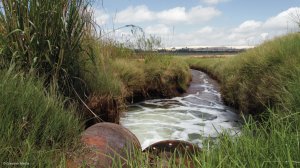Tailings extractor invests R1.5bn in long-term mine dump rehabilitation




Mintails' 1L8 mine dump on the West Rand of Johannesburg
Photo by Duane Daws
Acid mine drainage on the West Rand of Johannesburg
Photo by Duane Daws
Mintails chairperson Mark Brune
Photo by Duane Daws
JOHANNESBURG (miningweekly.com) – South Africa-focused tailings extractor Mintails has, to date, invested R1.5-billion into its mine closure operations and expects to spend an additional R85-million on closure costs by the time it ceases its planned operation in the next 20 years.
Addressing the media on Wednesday during a site visit to its operations on the West Rand of the Witwatersrand basin, near Krugersdorp, Mintails chairperson Mark Brune said there are about 5.5-billion tons of gold mine tailings spread over Johannesburg’s goldfields, from the Western basin to the Central and Eastern basins.
Mintails, he noted, aimed to process about six-million tons a year of slime, sand and hard rock.
The ASX-listed company currently had access to more than 200-million tons of slime and tailings on the West Rand, with one-million tons of tailings in the Randfontein Cluster of surface dumps, and a further 106-million tons of tailing resources at its Soweto Cluster, which it acquired from DRDGold historically.
The mine dumps, which were a source of dust and water pollution and seeped contaminants into groundwater, were increasingly “interfacing” with the urbanisation of Johannesburg.
“With seven-million people expected to migrate to Johannesburg over the next seven years, the management of this interface becomes an issue,” highlighted Mintails operations GM Jan Jacobs.
The rehabilitation of Mintails’ associated footprints would also release land that could be used for much-needed development in Gauteng.
The company rehabilitated mining areas using the closure-mining model, which engaged a wide group of stakeholders in an attempt to extend the life of the gold mining industry to facilitate a smooth transition from the mining to the postmining economy to ensure a rehabilitated environment with higher value economic use of land than the current environment the company operated in.
Mintails was, therefore, developing a single solution on the West Rand for multiple tailings facilities by mining historical tailings and depositioning these into a single deposition facility – the West Wits pit – which was identified for permanent closure, to leave a lasting legacy on the West Rand.
The West Wits pit had a 30-million-ton capacity up to ground level and would meet Mintails’ deposition requirements for the next 5 years at least.
Mintails envisioned the transformation of these tailings dumps into alternative-energy platforms, either solar or wind farms, capable of generating revenues to pay for the sustainable rehabilitation of other “unique” mining landscape features.
Consideration was being given to the creation of a wind farm located on top of the rehabilitated West Wits pit. The technical viability of such an approach was currently at the prefeasibility level – preliminary technical work had been initiated to investigate the viability of such a green solution.
Jacobs emphasised that the mining of the gold tailings provided an opportunity to rehabilitate and remedy the environmental impact of the unrehabilitated, decommissioned mines in Gauteng, noting that the removal of the dumps, and the associated rehabilitation of the footprints, would aid in the remediation of the radiation pollution on the West Rand.
The removal of these dumps would also decrease incidents of dust pollution and the pollution of water resources on the surface and underground.
Challenges faced in areas with unrehabilitated and decommissioned mines included the development of unsafe sinkholes that became access points for illegal mining.
Other challenges included mine dumps requiring constant and costly maintenance and management until a permanent resolution was identified, as the dumps tended to break down and spill over into the environment.
Old and abandoned infrastructure also needed to be dealt with, Jacobs said, highlighting the importance of finding a permanent solution to legacy issues, because “if they go unaddressed, we will once again be handing this issue down from one generation to the next”.
He noted three criteria that needed to be met to ensure the long-term sustainability of mine closure and rehabilitation. “One needs to address the criteria of economic return, in the form of jobs, social returns, in the form of gainful employment and skills, and environmental returns, in the form of water and land reform.”
A collaborative approach between society, professional support actors and regulators, and national government needed to be fostered, Jacobs said, to produce rehabilitated landscapes that were fit for purpose to mitigate all legacy issues and to remove any constraints to future socioeconomic development.
The landscapes also had to be functional ecosystems capable of supporting a diverse enough range of biological life to be considered healthy.
Comments
Press Office
Announcements
What's On
Subscribe to improve your user experience...
Option 1 (equivalent of R125 a month):
Receive a weekly copy of Creamer Media's Engineering News & Mining Weekly magazine
(print copy for those in South Africa and e-magazine for those outside of South Africa)
Receive daily email newsletters
Access to full search results
Access archive of magazine back copies
Access to Projects in Progress
Access to ONE Research Report of your choice in PDF format
Option 2 (equivalent of R375 a month):
All benefits from Option 1
PLUS
Access to Creamer Media's Research Channel Africa for ALL Research Reports, in PDF format, on various industrial and mining sectors
including Electricity; Water; Energy Transition; Hydrogen; Roads, Rail and Ports; Coal; Gold; Platinum; Battery Metals; etc.
Already a subscriber?
Forgotten your password?
Receive weekly copy of Creamer Media's Engineering News & Mining Weekly magazine (print copy for those in South Africa and e-magazine for those outside of South Africa)
➕
Recieve daily email newsletters
➕
Access to full search results
➕
Access archive of magazine back copies
➕
Access to Projects in Progress
➕
Access to ONE Research Report of your choice in PDF format
RESEARCH CHANNEL AFRICA
R4500 (equivalent of R375 a month)
SUBSCRIBEAll benefits from Option 1
➕
Access to Creamer Media's Research Channel Africa for ALL Research Reports on various industrial and mining sectors, in PDF format, including on:
Electricity
➕
Water
➕
Energy Transition
➕
Hydrogen
➕
Roads, Rail and Ports
➕
Coal
➕
Gold
➕
Platinum
➕
Battery Metals
➕
etc.
Receive all benefits from Option 1 or Option 2 delivered to numerous people at your company
➕
Multiple User names and Passwords for simultaneous log-ins
➕
Intranet integration access to all in your organisation





















